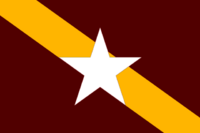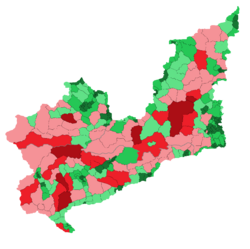User:Sandoria/Sandbox4
Separatism and regional identity in Paretia
Tosutonia
Tosutonia is likely the most active separatist movement in Paretia. Tosutons separatists see themselves as the most separated identity in Paretia. The Tosuton culture is the most unique of the peninsula as it is part of a separate language family closely related to the Gaullicans. Since the unification fo the peninsula in 1542 there have been numerous Tosuton rebellions, including the Vallverdú-Escolano Rebellion in 1656, which combined Esmeiran and Tosuton forces were defeated by the Luzelese ruled monarchy. The 1680 Sickle Revolt lead to the sickle becoming a symbol of Tosuton separatism. During the Pronunciamento the Tosutons attempted to separate again, declaring the first Tosuton Republic in Mausoleu, but were crushed again.
Separatist movements in Tosutonia fell down during the Turno Tranquilo when the Paretian government of the LNRM gave the Tosutons more representation. In Tosutonia the under construction Curs Purs Cathetral in Encerosa became a national symbol of the Tosuton people.
During the Functionalist Paretia era and Great War, Tosutonia became a bastion of left-wing politics in Paretia. It was home to many left-wing separatist resistance movements. The Bandera Estrella, the left-wing Republican flag of Tosutonia was created during the Great War. During the Republic of Paretia and Solarian War period, numerous separatist groups in Tosutonia popped up, these culminated in the 1950s with the creation of the People's Army of Tosutonia, of the EPT, a unification of the many left-wing nationalist separatist movements in Paretia. The EPT would resort to terrorist tactics during the 1950s and 1960s. The EPT was responsible for the 1958 Precea train station bombings, which killed 20 Paretian government officials, as well as the 1960 Encerosa hostage crisis, which saw anti-separatist Tosuton politicians taken hostage. In response to the terror tactics, Paretians elected the right-wing Popular Leadership Front, which allied with far-right and sotirian democrat parties to make a right-wing government. Under Premier Leonel Freitas, the government would begin to fight separatist elements in Tosutonia and other regions. The EPT was destroyed by 1970.
Separatism became less of an issue during the 1970s onward. The left-wing Socialists for Tosuton Independence and right-wing Liberty for Tosutonia parties were founded during the 1980s. The more peaceful approach to separatism continued during the 1990s and early 21st century. In 2006 a revival of the EPT was created in the form of the New People's Army of Tosutonia, this group would be less active than their predecessor.
A resurgence of Tosuton separatism came in 2021, during the leadership of the far-right Popular Victory government. Where Tosutonia's regional government would attempt, but ultimately fail to curb the VP government's anti-abortion law. This lead to massive protests for independence in the region, and the arrest of the leader of the Socialist for Tosuton Independence would lead to calls for a referendum. A referendum was allowed and held later in 2022, but the no vote would win. Separatism however became the most popular it has in decades.
Esmeira
Esmeira has fairly less separatist fervor compared to Tosutonia or Visega today, but historically it has attempted to gain independence from Paretia many times. Esmeira has it's own separatist movement that has lasted since the unification of the peninsula. Numerous Esmeiran attempts at independence occured in the early centuries of Paretia, usually they fought alongside Tosutons in numerous rebellions, the largest being the Vallverdú-Escolano Rebellion.
During the Pronunciamento the Esmeirans in Vallenoche declared the first Esmeiran Republic, similarly to it's Tosuton counterpart, it was swiftly taken down. During the Paretian Blessed Republic, which was mostly located in Etrurian-occupied Esmeira, Esmeirans attempted to turn it into an Esmeiran-centric nation, and reform it into the Esmeiran Blessed Republic. Their leader, Inigo Vergara, was Esmeiran, but rejected this proposal and wanted to unite the peninsula under an ecumenical republic. This proposal was also rejected by the Tosutons who had also joined the Blessed Republic.
During the Turno Tranquilo Esmeira became less interesting with separatism, as the government started to promote a pan-Paretian identity. During this period however an Esmeiran identity rebirth had begun to occur, with the creation of Esmeiran cultural symbolism, including at a world's fair held in Ocerto in 1896. During the functionalist era and Great War, Esmeiran separatist grew again, with the creation of a Republican Esmeiran flag, the Bandera Republicano.
The Esmeiran identity grew immensely during the Republic and the Solarian War. Similarly to it's Tosuton and Visegan counterparts it began to organize in the 1950s into groups, the largest being the Front for Homeland and Liberty, or the FPL, which would engage in terrorist actions during the 1950s and 1960s. It is responsible for being part of joint terror attacks with other separatist groups in this period. It however would come into conflict with Deguitan and Tenorian separatist groups who sought independence from Esmeira itself. The FPL and other groups were crushed by the 70s.
Separatism became less popular in Esmeira in the 1980s and 1990s, but political parties such as Separate! were founded in 1999. In 2022 a revival of separatism across party during the rule of the far-right Popular Victory has lead to the rebirth of the FPL and other groups in Esmeira, mostly being left-wing nationalist in nature.
Deguita
In Esmeira there are also separatist groups that seek independence from Esmeira itself. There are minorities in the east and western reaches of the region, being the Tenorians and Deguitans. The Deguitans are located on the Deguitan Plain and the border with Etruria. Deguita was conquered by Esmeira before the unification of the peninsula by Luzela. Independence movements in these regions have been around for longer than the major regions. Early on during the Paretian War Deguitans would attempt to separate but Luzela would also conquer them.
During the early centuries of Paretia, Deguitans would join the Esmeiran and Tosuton revolts against the Luzelese monarchy, but wanted promises by Esmeiran rebels to be given independence. This lead to conflict between the two groups. During the Pronunciamento these groups came into conflict as Esmeirans attempted to created an Esmeiran Blessed Republican that ruled the Deguitans and Tenorians.
During the Turno Tranquilo the LNRM government would allow the promotion of Deguitan culture. During the functionalist period and Great War, a socialist front of Deguitans formed. They would attempt to join the Esmeiran movement. During the Republic and Solarian War, these groups would have a falling out and come into conflict with each other. The Deguitan movement died out in the 60s, and today is much smaller and mainly seeks to become an independent region from Esmeira.
Tenoria
Tenorians are located around the cities of Larozia and Vallenoche, and also were conquered by the Esmeirans early on. They would join the Deguitans in their fight for independence. They attempted to separate during the Paretian War but failed. Later they continued their push for independence.
During the Pronunciamento the Blessed Republic came into conflict with the Tenorians, who sought independence for themselves. During the Turno Tranquilo their culture saw a revival with government promotion. During the functionalist era, left-wing separatists joined the Deguitans, in the Republic they too would come into conflict with the Esmeiran separatists. During the 1950s their separatist groups would not be able to accomplish much due to their conflict with the Esmeiran separatists.
Tenorian separatism began to fall off in the 1960s. Tenorian culture began to be less promoted during this period. Today Tenorian separatist is less common than Deguitan, and has only recently seen a revival under the Popular Victory government.
Visega
Early on Visega was seen as an ally of the Luzelese, as they sided with them during the Paretian War. The Visegans had not rebelled as much as the Tosutons or Esmeirans during the early history of Paretia. This began to change after the abolishment of the Visegan regional monarchy under Henrique III, which saw their representation in the Luzelese government fall apart. During the Pronunciamento the Visegans began to rebel for the first time in numbers, such as in the city of Tigo, where the short-lived Visegan Republic existed, it would be crushed by the monarchy but it would leave an independence movement to exist in the region.
During the Turno Tranquilo a massive revival of Visegan culture occured, the Visegan saw themselves as a unique identity in Paretia with history that goes back to Tenic cultures. The Visegan separatist movement began to grow during the functionalist period of Paretia and during the Great War, with the creation of a leftist separatist Visegan group known as the Republican Army of Visega, or the ERV. it is commonly seen as the first of the major militant separatist groups in Paretia that existed in the middle 20th century.
During the Republic and Great War period the ERV became a large militant group that allied with the Tosuton and Esmeiran separatist movements. During the 1950s and 1960s it would engage in similar terrorist tactics as the Tosuton and Esmeiran separatists. These attacks caused backlash int the country, which lead to the right-wing Freitas government to stamp out separatist movements. By the 1970s the ERV was disbanded and destroyed.
During the 1980s separatist thought became less popular, but in 1991 the Rally Together party was founded for a political method of separatism. Later on separatism saw a revival in Paretia in the 21st century, in 2010 the militant group Terras Libres was founded. In 2022 a massive resurgence in separatism saw the popularity of Terras Libres grow.
Luzela
The Luzelese today are widely considered dominant nation of Paretia. Separatism is uncommon in Luzela. There are regionalist movements but separatism has not become a major part of Luzela like the other regions. There are separatist parties such as the Luzelese Independence Party, but they are fairly small compared to other separatist parties in the other regions.
Militant separatism is even more rare, there are no known militant separatist groups in Luzela. There are pan-nationalist unionist groups that are militant in nature that seek to stop separatism in the other regions, including the Pan-Paretian Force. These groups however are very small and unpopular in Luzela. The Luzelese identity is surrounded on being the founding nation of Paretia.
Mausoterra
Mausoterra is the land between Luzela and Tosutonia, where cities such as Herança, Mausoleu, Quiscarmã are located. The Mausoterran identity arose during the middle ages before the unification of Paretia. They spoke Eastern Tosuton and the Kingdom of Mausoterra was separate from the rest of Tosutonia. The demographics of the regions began to change as Luzelese began to settle westward and founded the Principality of Herança. This became the starting point for what became the Paretian War.
The Luzelese eventually became the dominant culture in the eastern areas of the region. Since then the idea of "Mausoterra" fell apart, but during the 20th century a revival of culture in Mausoterra lead to the creation of a Mausoterran identity, that is both a mixture of Luzelese and Tosuton culture. Movements to create an independent constituent region of Mausoterra began to grow in recent years. As well as a full-on separatist movement, although not as popular as the other separatist movements in Paretia.
1991 Paretia Euclean Community membership referendum
| Paretia Euclean Community membership referendum | ||||||||||||||||||||||
|---|---|---|---|---|---|---|---|---|---|---|---|---|---|---|---|---|---|---|---|---|---|---|
| Should the United Kingdom become a member of the Euclean Community? | ||||||||||||||||||||||
| Location | Paretia | |||||||||||||||||||||
| Date | 17 May 1991 | |||||||||||||||||||||
| ||||||||||||||||||||||
| ||||||||||||||||||||||
| On the map, the darker shades for a colour indicate a larger margin. | ||||||||||||||||||||||
| 2022 Tosuton Independence Referendum | |
|---|---|
| Should Tosutonia leave the United Kingdom and become an independent country? | |
| Location | Tosutonia |
| Date | 7 October 2022 |
| On the map, the darker shades for a colour indicate a larger margin. | |




